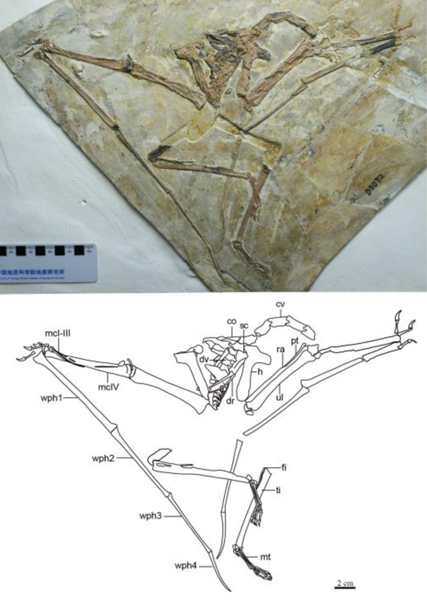Remarkable Headless Pterosaur Defines an Entire Genus
A headless pterosaur fossil has provided palaeontologists with a blueprint to workout which flying reptile fossils represent juveniles and which fossils represent fully-grown adults. The specimen which consists of partially articulated, postcranial material was collected privately before coming into the vertebrate fossil collection of the Dalian Natural History Museum, Liaoning Province (China). Partially fused bones indicate that the specimen represents a juvenile of the tapejarid pterosaur species Sinopterus dongi. As such, it provides a fantastic comparator enabling scientists to differentiate between pterosaur fossils representing animals at different growth stages as well as helping to determine which pterosaur fossils should be attributed to different species.

Specimen D3072 (Sinopterus dongi) view of the fossil (A) and accompanying line drawing (B). Note scale bar in (B) equals 2 cm. Picture credit: Shen et al.
Picture credit: Shen et al
Nemicolopterus – Unravelling the Jehol Biota
It is very likely that the fossil came from a location close to Chaoyang City (Liaoning), from rocks belonging to the Jiufotang Formation. Fossils from the Jiufotang Formation (early Aptian age), together with those associated with the underlying Yixian Formation (Barremian to early Aptian) and the Barremian-aged Huajiying Formation of the Sichakou-Senjitu Basin form the Jehol biota.
Several different types of pterosaur are associated with these strata and tapejarids are the most abundant. To date, there have been ten described specimens and dozens still awaiting formal study. Classifying the fossils and identifying genera and species has proved problematic.
For example, the tiny pterosaur Nemicolopterus heralds from the Jiufotang Formation and there is some debate whether the fossil specimen is a distinct species, or whether the fossil represents a very young Sinopterus.
The newly studied specimen (D3072), might be missing its skull, but a detailed analysis reveals partially fused bones indicating that this is a juvenile. The fossil has been assigned to the tapejarid species Sinopterus dongi. Specimen number D3072 is so complete and well-preserved (some parts of the skeleton are in better condition than other parts), it has provided the research team with valuable information on the anatomical characteristics of young tapejarid pterosaurs.
A spokesperson from Everything Dinosaur explained:
“Specimen number D3072 is like the Rosetta stone that archaeologists were able to use to decipher Egyptian hieroglyphics. The fossil provides valuable information on the anatomy of juvenile tapejarids and it will help palaeontologists to work out which pterosaur fossils represent juveniles of already named species and which fossils may represent entirely new species.”
The research team have proposed that D3072 becomes the type specimen for Sinopterus dongi and they are confident that it will help shed new light on the osteology of the Sinopterus genus. It will provide a blueprint, playing a significant role in future comparative studies and helping to resolve taxonomic issues.
The scientific paper: “A new specimen of Sinopterus dongi (Pterosauria, Tapejaridae) from the Jiufotang Formation (Early Cretaceous, China)” by Caizhi Shen, Rodrigo V. Pêgas, Chunling Gao, Martin Kundrát, Lijun Zhang, Xuefang Wei and Xuanyu Zhou published in PeerJ.
The Everything Dinosaur website: Dinosaur and Pterosaur Toys.


